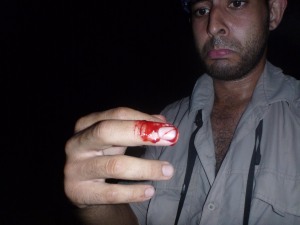Field biologist and conservationist George Madani describes his near-death experience with a slow loris. This account is soon to be published as a medical case study written by Madani and Nekaris in the Journal of Venomous Animals Including Tropical Diseases. Without medical intervention, George almost certainly would have died…
As a field biologist working in Australia I’ve had my fair share of perilous creatures to contend with. Deadly snakes with venom potent enough to kill a man several times over. Bone crunching, limb tearing crocodiles lurking in billabongs and rivers of the north . Even our toilets aren’t safe with the infamous Redback spider lurking in their favourite haunt of the noble outback dunny.
So when I visited Borneo a couple of years ago I thought the greatest danger I might face would have perhaps been with one of their legendary vipers or cobras. Maybe I would end up as lunch from an elusive neck seizing clouded leopard or perhaps being trampled by a herd of startled stampeding jungle elephants. Little did I think that I would be undone by a small, cute and furry little mammal.
Having been afflicted with a desire to catch and admire most critters from a young age I met my match in Borneo by what I thought to be the most unlikely of candidates. It was with considerable excitement that I came across my first wild slow loris, which inadvertently led to too close an encounter and ultimately the teeth of this nocturnal primate sunk deeply into my finger.

Following a painful and frightening adventure into anaphylaxis I had a crash course into understanding that these cute little forest gremlins pack quite the punch being one of the worlds very few venomous mammals. The photos speak for themselves and if I can’t serve as a good example then I can certainly serve as warning! Leave the loris alone!
Read more about slow loris venom here

